Leo V, King of Armenia
| Levon V | |
|---|---|
 | |
| King of Armenia | |
| Reign | 1374–1375 |
| Coronation | 14 September 1374 |
| Predecessor | Constantine IV |
| Born |
c. 1342 Cyprus |
| Died |
29 November 1393 Hôtel des Tournelles, Paris |
| Burial | Saint Denis Basilica |
| Spouse | Margaret of Soissons |
| House | House of Lusignan |
| Father | John constable of Armenia |
| Mother | Soldane |
| Religion | Roman Catholic |
| Signature |
|
Leo V or Levon V (occasionally Levon VI; Armenian: Լևոն, Levon V; 1342 – 29 November 1393), of the House of Lusignan, was the last Latin king of the Armenian Kingdom of Cilicia. He ruled from 1374 to 1375.
Leo was described as "Leon V, King of Armenia" on his own personal seal ("SIGILUM LEONIS QUINTI REGIS ARMENIE"),[1] and as "Leon de Lusignan the Fifth" in the Middle French inscription on his cenotaph: Leon de Lizingnen quint.[2]
Family and early life
Leo was the son of John constable of Armenia, Constable and Regent of Armenia. According to the contemporary chronicler Jean Dardel, Leo's mother, Soldane, was the daughter of a Georgian king. Soldane is otherwise unknown from the medieval sources, and scholars such as Rüdt-Collenberg have cast doubt on the credibility of Dardel's genealogy. Surviving documentary evidence suggests that Jean de Lusignan never married Leo's mother and she was, rather, his concubine.[3][4]
Constantine V, in order to wipe out all claimants to the throne, had given orders to kill Leo and his brother Bohemond, but they escaped to Cyprus before the murder could be carried out. He was made a Knight of the Chivalric Order of the Sword in 1360 and Titular Seneschal of Jerusalem on October 17, 1372.
King of Armenia
Leo was elected to the throne on the death of his distant cousin Constantine VI of Armenia in 1373.[5] After a short regency by Mary of Korykos, widow of Constantine, Leo left Famagusta in spite of the ongoing conflict between Cyprus and Genoa. Landing at Korykos, he managed with difficulty to reach Sis, which was already being besieged by the Muslim emir of Aleppo.[6] Leo and his wife, whom he married at Cyprus in May, 1369, Marguerite of Soissons, daughter of Jean de Soissons and wife, were crowned at Sis on July 26 or September 14, 1374, according to both the Latin and Armenia rites. His right to the throne was challenged by Ashot and Leo's short reign was marked by numerous disputes between the various factions.
After several battles against superior Mamluk forces, he locked himself in the fortress at Geben (Armeina: Gaban) and eventually surrendered in 1375,[7] thus putting an end to the last Armenian state until the establishment of the short lived Democratic Republic of Armenia (1918–1920) and the Republic of Armenia in 1991.[1]
The Mameluks took Leo to Cairo with his family, where he was placed under surveillance for several years.[8] In August 1377, he met with Jean Dardel, a Franciscan who was on his way for a pilgrimage to Jerusalem. Leon befriended him and employed him as his secretary. Dardel returned to Europe to plead the case of Leon V, and managed to convince King John I of Castile to pay a ransom of precious stones, silks, and birds of prey in 1382.[8] His wife had died in Cairo, between 1379 and July 4, 1381.
Life in Europe
Leon de Lusignan arrived ill and poor to Medina del Campo. In 1382 or 1383, the King of Castile named Leon Lord of Madrid.[9] John I granted him for life the town of Madrid, Andújar, Guadalajara and Villareal (today Ciudad Real) and a yearly gift of 150,000 maravedis.[10] Leon rebuilt the towers of the Royal Alcázar.
According to Father Mariana, Leon left Castile for France after the death of his protector in 1390. Federico Bravo, however, states that he left after two years of ruling, and five years later, the Madrilenians were conceded the revocation of the lordship by John. Leon V apparently went to Paris in June 1384, and received the Saint-Ouen castle and a sizable pension from King Charles VI of France.[8] He attempted to reconcile the French and the English (as the time fighting the Hundred Years' War) in order to set up a new Crusade[1] and obtain help to recover his lands, but the meeting he organized in 1386 between Boulogne and Calais were unsuccessful.[8] Leon continued diplomatic mission to England in 1389 and in 1392.
Death

Leon V never recovered his throne, and died in Paris on November 29, 1393. His remains were laid to rest in the Couvent des Célestins, near Place de la Bastille in Paris, the second most important burial site for royalty after Saint-Denis.[5] The prestigious convent was located nearby Leon's residence of Hôtel des Tournelles, itself near Hôtel Saint-Pol, the favourite residence of Charles V and Charles VI in the area of Le Marais.
Leon received lavish funerals and had a lavish tomb, located in the choir of the church. However, the convent was profanated during the French Revolution.[1][5] After the revolution, his tombstone was recovered by Alexandre Lenoir who placed it in his Musée des monuments Français in the Saint-Denis Basilica. In 1815, during the Restoration, a new cenotaph was established for Leon V at the royal Saint Denis Basilica where most representatives of the French monarchy lie.
The effigy on the tombstone, by an anonymous artist, is of a high realism and quality, and it is thought that it was made while Leon was still alive.[8] Leon V is depicted holding a scepter (now broken) and gloves, symbol of great princes. The tombstone bears the following inscription in French:
"Here lies the right noble and excellent Prince Leon de Lusignan V, Latin king of the kingdom of Armenia, who passed away in Paris on the 29th day of November of the year of Grace 1393. Pray for him."[11]
("Cy gist tres noble et excellent prince Leon de Lizingnen quint roy latin du royaume d'Armenie qui rendit l'ame a Dieu a Paris le XXIXe jour de novembre l'an de grace M.CCC.IIIIXX.XIII. Priez pour luy") Original 14th century inscription.[12]

He had one legitimate daughter, Marie de Lusignan (ca 1370 – Cairo, before July 4, 1381, who predeceased her mother and father), and two illegitimate sons, Guy de Lusignan or Guido de Armenia (died 1405), a Canon in Autun, Bayeux, Paris and Arras and Captain de la Tour d'Amblay, and Stephan or Etienne de Lusignan, a Knight in Sis.
Upon his death the title of King of Armenia was claimed by Leo's distant cousin James I.
See also
Notes
- 1 2 3 4 Mutafian, p.90
- ↑ Full text of the cenotaph with translation hereunder.
- ↑ Rüdt-Collenberg, William Henry (1963). The Rupenides, Hethumides and Lusignans; the structure of the Armeno-Cilician dynasties. Paris: Librairie C. Klincksieck. pp. 74–76.
- ↑ MacEvitt, Christopher (2009). "The King, the Bishop, and the Dog Who Killed Him: Canine Cultural Encounters and Medieval Armenian Identity". In Bailey, Lisa; Diggelmann, Lindsay; Phillips, Kim M. Old worlds, new worlds: European cultural encounters, c.1000-c.1750. Turnhout Brepols Publishers. p. 46. ISBN 978-2-503-53132-8.
- 1 2 3 Basmadjian, K. J. (Nov–Dec 1920). "Cilicia: Her Past and Future". The New Armenia. 12 (11-12): 168–9.
- ↑ Mutafian, p.89
- ↑ Edwards, Robert W. (1987). The Fortifications of Armenian Cilicia: Dumbarton Oaks Studies XXIII. Washington, D.C.: Dumbarton Oaks, Trustees for Harvard University. pp. 10, 125, 234. ISBN 0-88402-163-7.
- 1 2 3 4 5 Mutafian, Leon V
- ↑ Un Madrid insólito: Guía para dejarse sorprender, pg. 39–40. Jesús Callejo. Editorial Complutense, 2001. ISBN 84-7491-630-5. The book, however, talks about Leon V of Armenia since Leo I of Armenia isn't counted as a King by some authors.
- ↑ http://www.dupalu.com/2015/03/sabias-que-madrid-fue-durante-8-anos-un.html?m=1
- ↑ Translation by Pierre-Yves Le Pogam, Tomb of Leon V de Lusignan
- ↑ Source (PDF)
References
- Boase, T. S. R. (1978). The Cilician Kingdom of Armenia. Edinburgh: Scottish Academic Press. ISBN 0-7073-0145-9.
- Mutafian, Claude (2001). Le Royaume Arménien de Cilicie. Paris: CNRS Editions. ISBN 2-271-05105-3.
- Claude Mutafian, Leon V of Lusignan, last king of Armenia (PDF)
- Pierre-Yves Le Pogram, Tomb of Leon V de Lusignan (PDF)
External links
| Leo V, King of Armenia Born: unknown 1342 Died: 29 November 1393 | ||
| Regnal titles | ||
|---|---|---|
| Preceded by Constantine VI |
King of Cilician Armenia 1374–1375 |
Malmuk conquest |
| Malmuk conquest | — TITULAR — King of Cilician Armenia 1375–1393 |
Succeeded by James I |